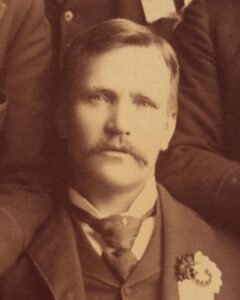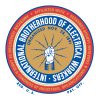Th e International Brotherhood of Electrical Workers (IBEW) is the most established and extensive electrical union in the world, existing as long as the commercial use of electricity. From the beginning, workers realized the importance—and danger—of electricity. As the industry grew, electricians began organizing themselves and setting the stage for increased safety measures, fair pay, and a better standard of living.
1844–1880
THE DAWN OF ELECTRICITY
Th e telegraph was the fi rst electrical accomplishment of commercial importance, and it transformed the practical application of electricity, which most people of the time believed to be an interesting but dangerous experiment.
For the first time, messages could be transmitted to people over great distances. In 1844, the first telegraph wires were strung between Washington, DC, and Baltimore, Maryland, carrying the famous message of Samuel Morse,
“What hath God wrought?” An Industry Is Born…
In 1848, the first telegraph station was built in Chicago, Illinois. By 1861, a web of telegraph lines spanned the United States; and in 1866, the first permanent telegraph cable was successfully laid across the Atlantic Ocean. Hiring linemen to string the new network of wires was a necessity, and young men across the land flocked eagerly to be a part of this new and
exciting profession.
Th e general public became increasingly aware of the possibilities of electricity when the telephone was introduced in 1876 and with Thomas Edison’s invention of the first successful incandescent lamp in 1879. Electricity began to transform American life. In 1882, the first U.S. central power station was built in New York City. Known as the Pearl Street Generating Station, it was capable of lighting 85 buildings. As public demand for electricity increased, the number of electrical workers continued to grow. Where once only a few intrepid linemen handled electricity, many now appeared on the scene, along with wiremen, seeking their life’s work. Th is rapid expansion of the electric power and light industry kept demand for labor high. However, employers kept wages low by hiring an untrained workforce. Without proper training, the industry was overrun by individuals with inadequate skills and insufficient knowledge to practice the trade with proper regard for safety—making an already dangerous job more risky. The surge toward unionism was born out of the industry’s deplorable safety conditions and workers’ demand for higher standards and pay.
Early Signs of Unity
Beginning in 1870, many small electrical unions were organized, only to disappear shortly thereafter. By 1880, enough telegraph linemen had organized themselves to form a local assembly, which affiliated with the Knights of Labor, an important labor organization of the day that was established in 1869. A few more local assemblies were organized, and a district council was formed. In 1883, this council called a strike against the Western Union telegraph company, demanding 8-hour workdays, an increase in pay, and equal pay for women. Th e strike failed aft er 1 month and broke up the first known attempt to organize electrical workers.
Despite the defeat, the desire for workers to unite remained strong. In 1884, a group of linemen formed an organization called the United Order of Linemen. The group was headquartered in Denver, Colorado, and was able to organize a considerable number of linemen in the Midwest and western United States. However, it was not until a few years later that our Brotherhood would be formed.
1890
THE BEGINNINGS OF BROTHERHOOD
In 1890, the St. Louis Exposition, an annual agricultural and technical fair, featured electrical wonders of the era. Wiremen and linemen from all over the United States flocked to St. Louis, Missouri, the fourth largest city in the United States at the time, to wire the buildings and erect the exhibits. The exposition workers got together at the end of each long workday and talked about the toil and conditions for those in the electrical industry. Th e story was the same everywhere: The work was hard, the hours were long, and the pay was spare. It was common for a lineman to risk his life on the high lines in all kinds of weather for 12 hours a day, 7 days a week. Two dollars and fift y cents a day was considered an excellent wage for wiremen, and many electrical workers were forced to accept work for just $8 a week. However, skilled laborers in other trades earned more. By comparison, plumbers in large cities averaged a daily wage of $3.37and bricklayers and masons earned an average
of $3.88 per day.
Another concern was that there was no training, and safety standards were nonexistent. In some areas, the mortality rate for linemen was one out of every two hired, and the national mortality rate for electrical workers was twice the national average for all other industries.
A Union Forms
A union was the logical answer for the many problems facing these workers; so the small group of electricians meeting in St. Louis sought help from the American Federation of Labor (AFL) to unionize. An organizer named Charles Kassel was assigned to help them, and in 1890 the group was chartered as the Electrical Wiremen and Lineman’s Union, No. 5221, or the AFL Federal Labor Union 5221. A St. Louis lineman, Henry Miller, was elected president. It was apparent to Miller and the other workers at the exposition that their small union was merely a starting point. Only a national organization of electrical workers with jurisdiction covering the entire industry could win better treatment from the large corporate telephone, telegraph, electric power, electrical contracting, and electrical equipment manufacturing companies.
Early Leaders Set the Pace
Henry Miller was a man of remarkable courage and energy. J.T. Kelly, the first secretary of our Brotherhood, said of Miller, “No man could have done more for our union in its first years than he did.” Miller packed his tools and an extra shirt in an old carpetbag and rode the rails to many U.S. cities to work the trade. The receiving committee for Miller’s arrival in a city was oft en a “railroad bull”—a policeman who chased him and tried to put him in jail for his unauthorized mode of travel. Nonetheless, Miller persevered. Everywhere he went, he organized the electrical workers he met into local unions. Largely because of Miller’s work, a great deal was accomplished in that first year of the union. Local unions chartered by the AFL and other electrical unions were organized all over the United States, including Chicago; Milwaukee, Wisconsin; Evansville and Indianapolis, Indiana; Louisville, Kentucky; New Orleans, Louisiana; Cincinnati and Toledo, Ohio; Philadelphia and Pittsburgh, Pennsylvania; Duluth, Minnesota; and New York City.
To learn more about the history of IBEW download this PDF.
